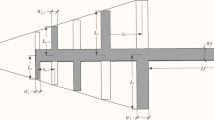Abstract
A compact printed multiple-input multiple-output antenna is presented for USB dongle application which covers the WLAN (2.4–2.48 GHz), WiMAX (3.4–3.8 GHz), and HiperLAN (4.7–5.83 GHz) bands. The two monopoles are closely spaced on the PCB at distance of about \( 0.094\,\lambda_{0} \) at lowest resonant frequency. To reduce the mutual coupling between the ports as well as to get the desired operating bands, combination of Ω-shaped neutralization line and L-shaped slots [defected ground structure (DGS)] are used. Due to which aimed frequency bands as well as better than −14 dB isolation are achieved. The mechanism of neutralization line and DGS are analysed based on the S-parameters and surface current distributions. An equivalent circuit model is also used to understand the mechanism of the neutralization line alone. The envelope correlation coefficient and ratio of mean effective gain are calculated which are found to be well below 0.4 and close to unity, respectively.













Similar content being viewed by others
References
Foschini, G. J., & Gans, M. J. (1998). On limits of wireless communication in a fading environment when using multiple antennas. Wireless Personal Communication, 6(3), 311–335.
Wireless LAN specification to provide significantly improved data throughput and range, The IEEE Standard Association (online). http://standards.ieee.org/announcements/ieee802.11n_2009amendment_ratified.html
Su, S.-W., Lee, C.-T., & Chang, F.-S. (2012). Printed MIMO-antenna system using neutralization-line technique for wireless USB-dongle applications. IEEE Transactions on Antennas and Propagation, 60, 456–463.
Liao, W.-J., Chang, S.-H., Yeh, J.-T., & Hsiao, B.-R. (2014). Compact dual-band WLAN diversity antennas on USB dongle platform. IEEE Transactions on Antennas and Propagation, 60, 109–117.
Kwon, J., Kim, D., Lee, Y., & Choi, J. (2011). Design of a MIMO antenna for USB dongle application using common grounding. In International conference on advanced communication technology (ICACT-2011) (pp. 313–316), Seoul.
Li, Z., Han, M.-S., Zhao, X., & Choi, J. (2010). MIMO antenna with isolation enhancement for wireless USB dongle application at WLAN band. In Asia-Pacific microwave conference-2010 (pp. 758–761), Yokohama.
Mak, A. C. K., Rowell, C. R., & Murch, R. D. (2008). Isolation enhancement between two closely packed antennas. IEEE Transactions on Antennas and Propagation, 56, 3411–3419.
Zhang, S., Lau, B. K., Sunesson, A., & He, S. (2012). Closely-packed UWB MIMO/Diversity antenna with different patterns and polarization for USB dongle applications. IEEE Transactions on Antennas and Propagation, 60, 4372–4380.
Ansoft’s High Frequency Structure Simulator (HFSS); (online). http://www.ansoft.com
Computer Simulation Technology Microwave Studio (CST MWS), (online). http://www.cst.com
Ogawa, K., & Uwano, T. (1994). A diversity antenna for very small 800-MHz band portable telephones. IEEE Transactions on Antennas and Propagation, 42, 1342–1345.
Diallo, A., Luxey, C., Thuc, P. L., Staraj, R., & Kossiavas, G. (2006). Study and reduction of the mutual coupling between two mobile phone PIFAs operating in the DCS1800 and UMTS bands. IEEE Transactions on Antennas and Propagation, 54, 3063–3074.
Wang, Y., & Du, Z. (2014). A wideband printed dual-antenna with three neutralization lines for mobile terminals. IEEE Transactions on Antennas and Propagation, 62, 3063–3074.
Balanis, C. A. (2008). Antenna theory: Analysis and design. New York: Wiley.
Blanch, S., Romeu, J., & Corbella, I. (2003). Exact representation of antenna system diversity performance from input parameter description. Electronics Letters, 39, 705–707.
Vaughan, R. G., & Andersen, J. B. (1987). Antenna diversity in mobile communications. IEEE Transactions on Vehicular Technology, VT-36, 149–172.
Schwartz, M., Bennett, W. R., & Stein, S. (1965). Communication system and techniques (pp. 470–474). New York: McGraw-Hill.
Pierce, J. N., & Stein, S. (1960). Multiple diversity with non independent fading. Proceedings of the IRE, 1960(48), 89–104.
Taga, T. (1990). Analysis for mean effective gain of mobile antennas in land mobile radio environments. IEEE Transactions on Vehicular Technology, 39, 117–131.
Karaboikis, M. P., Papamichael, V. C., Tsachtsiris, G. F., Soras, C. F., & Makios, V. T. (2008). Integrating compact printed antennas onto small diversity/MIMO terminals. IEEE Transactions on Antennas and Propagation, 56, 2067–2078.
Singh, H. S., Meruva, B. R., Pandey, G. K., Bharti, P. K., & Meshram, M. K. (2013). Low mutual coupling between MIMO antennas by using two folded shorting strips. Progress in Electromagnetic Research B, 53, 205–221.
Author information
Authors and Affiliations
Corresponding author
Rights and permissions
About this article
Cite this article
Singh, H.S., Shalini & Meshram, M.K. Printed Monopole Diversity Antenna for USB Dongle Applications. Wireless Pers Commun 86, 771–787 (2016). https://doi.org/10.1007/s11277-015-2956-3
Published:
Issue Date:
DOI: https://doi.org/10.1007/s11277-015-2956-3




